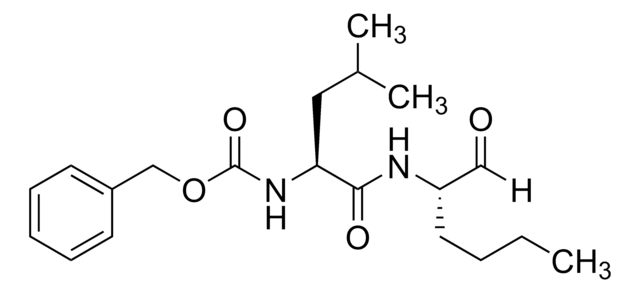03-34-0051
Calpeptin
A cell-permeable calpain inhibitor (ID₅₀ = 52 nM for calpain-1; ID₅₀ = 34 nM for calpain-2; ID₅₀ = 138 nM for papain).
Synonym(s):
Calpeptin, Benzyloxycarbonylleucyl-norleucinal
About This Item
Recommended Products
Quality Level
Assay
≥94% (HPLC)
form
solid
manufacturer/tradename
Calbiochem®
storage condition
OK to freeze
color
white to off-white
solubility
DMF: 5 mg/mL
DMSO: 5 mg/mL
shipped in
ambient
storage temp.
−20°C
InChI
1S/C20H30N2O4/c1-4-5-11-17(13-23)21-19(24)18(12-15(2)3)22-20(25)26-14-16-9-7-6-8-10-16/h6-10,13,15,17-18H,4-5,11-12,14H2,1-3H3,(H,21,24)(H,22,25)/t17-,18-/m0/s1
InChI key
PGGUOGKHUUUWAF-ROUUACIJSA-N
General description
Biochem/physiol Actions
Packaging
Warning
Sequence
Preparation Note
Other Notes
Yamazaki, T., et al. 1997. Biochemistry27, 8377.
Klafki, H., et al. 1996. J. Biol. Chem.271, 28655.
Shiba, E., et al. 1996. Anticancer Res. 16, 773.
Pinter, M., et al. 1994. Neurosci. Lett. 170, 91.
Saito, K., and Nixon, R.A. 1993. Neurochem. Res. 18, 231.
Tsujinaka, T., et al. 1988. Biochem. Biophys. Res. Commun.153, 1201.
Legal Information
Storage Class Code
11 - Combustible Solids
WGK
WGK 3
Flash Point(F)
Not applicable
Flash Point(C)
Not applicable
Certificates of Analysis (COA)
Search for Certificates of Analysis (COA) by entering the products Lot/Batch Number. Lot and Batch Numbers can be found on a product’s label following the words ‘Lot’ or ‘Batch’.
Already Own This Product?
Find documentation for the products that you have recently purchased in the Document Library.
Related Content
Select different protease inhibitor types based on your needs to prevent protein degradation during isolation and characterization and safeguard proteins in sample prep.
Select different protease inhibitor types based on your needs to prevent protein degradation during isolation and characterization and safeguard proteins in sample prep.
Select different protease inhibitor types based on your needs to prevent protein degradation during isolation and characterization and safeguard proteins in sample prep.
Select different protease inhibitor types based on your needs to prevent protein degradation during isolation and characterization and safeguard proteins in sample prep.
Our team of scientists has experience in all areas of research including Life Science, Material Science, Chemical Synthesis, Chromatography, Analytical and many others.
Contact Technical Service








